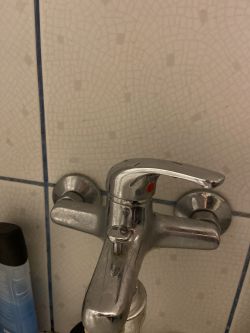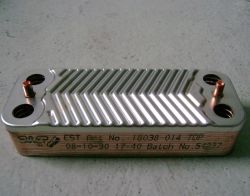Jolanta56 wrote: It`s very difficult for me to conduct this professional discussion because I know so little;
If you have various equipment at home, you need to train it or have someone at home to help you, and if not, you need to seek help from a specialist.
I believe that the topic of aerators does not require a doctorate, but at the beginning everything new seems strange and difficult.
Jolanta56 wrote: It serves 2 independent apartments: ground floor and first floor central heating and taps.
and this is the problem, because what happens in one apartment affects the other apartment. The efficiency of the boiler with the tank is limited and if the technical capabilities are exceeded, it will be a problem, but if it does, it will only be temporary, because after 15-20 minutes the tank should be recharged and we will have full efficiency again for the first minutes.
Jolanta56 wrote: Probably because the faucet has a thermostat, so that in the event of activation of many draw-off points, cold water does not suddenly fall on the bather`s head? ( Do I think right).
The thermostatic faucet does not produce hot water, so theoretically it may happen that someone will be supplied with cold water.
If the faucet receives hot water at the input, it will mix it so that at the output it finally receives water at the set temperature on the faucet.
In other words, if you have water at a temperature of 45 degrees in the tank, you will not suddenly get 50 degrees on the faucet, but a maximum of 45 degrees or less, depending on the settings on the faucet.
In the case of a classic faucet, you have to manually mix hot and cold to ensure proper comfort and avoid burns. In a thermostatic faucet, the thermostat ensures that the hot water maintains the set temperature. This means that the temperature in the tank is e.g. 45 degrees, then you set the temperature on the faucet to e.g. 38 and at the outlet from the faucet you get 38, but if there is not enough hot water in the tank, cold water may soon flow despite the set 38 degrees.
Jolanta56 wrote: there is a boiler in the basement: auroCOMPACT/2 VSC S. Vaillant solar-gas condensing boiler. Standing. I know it has a water reservoir in it.
you have the so-called The "fridge" is a large block with a built-in stratified tank, so in theory there should be no problem with hot water, I originally assumed that you had a hanging boiler, just like me, because most people use such things.
I don`t know exactly what your model is, but I found the technical data for the model:
VSC S INT 196/2-C 200 H
- layered tank 150 l
- maximum domestic hot water heating power 23kW
- continuous hot water capacity 570 l/h for 23kW, which gives 9.5 l/min
- initial hot water capacity 185 l/10 min
The way I understand these parameters is that we have an average of 18.5 l/min for the first 10 minutes until we use up the heat stored in the tank, and then the efficiency drops to a continuous value of 9.5 l/min.
If, for example, in the second apartment they have a rain shower with a capacity of 15 l/min, after a 10-minute shower they will use almost all the water and then the efficiency will drop to a maximum of 9.5 l/min.
This is acceptable for 1 hot water consumption point, but for 2 apartments at the same time it is not enough.
Of course, when someone empties the tank and finishes washing, the boiler should replenish the supply of c within 15-20 minutes..water and then the initial efficiency will again be at the initial level of 18.5 l/min.
I would like to remind you that continuous efficiency is calculated for the temperature difference, i.e. delta t = 30 degrees.
If the actual temperature of cold water is 7 degrees, then with a capacity of 9.5 l/min we will heat the water only to 37 degrees. If necessary, we can obtain 45 degrees, but the missing 8 degrees will affect the efficiency, which will drop from 9.5 to approximately 7.5 l/min.
But on the other hand, if we have 45 degrees in the tank and need 38 degrees at the outlet from the faucet, we mix hot and cold, so the consumption of hot water will be correspondingly lower.
It is something like a system of communicating vessels ;-)
Assuming that the thermostatic faucet is functional, if you have hot water in the tap and cold water in the shower, there is a chance that the aerator will help.
If one boiler supplies two apartments, it is best if both apartments have aerators that limit the maximum water flow.
Taking into account the continuous maximum theoretical efficiency of 9.5 l/min, I would install aerators everywhere so that the actual efficiency of one water intake point does not exceed 8 l/min.
A stream of 8 l/min should provide a satisfactory stream of water in the shower and reduce the risk of lack of hot water, and in the case of a charged tank, it will ensure the comfort of domestic hot water for the first approx. 10 minutes when using two hot water consumption points at the same time.
Taps may have aerators of 5-6 l/min.
On the other hand, if you have a boiler with a built-in tank, there should be a period when you will not run out of hot water and there should be no problem for 24 hours, and only temporarily, when both apartments will consume hot water at the same time.
If you always have problems with the shower, then I would tend to think that the faucet is to blame, and then it may require some cleaning, descaling or replacing with a new one.
Jolanta56 wrote: I might also add that in the apartment I live in (ground floor) there is a device on the wall for regulation: the set temperature of domestic water there is 45 degrees.
I have my boiler set to 38 degrees and when using water without mixing it with cold water, it is acceptable to me.
As for aerators, I bought the Neoperl brand, but there are also others on the market, I don`t remember the brands anymore, because this topic is from several years ago.
 )
)



